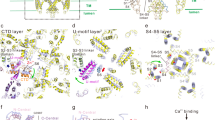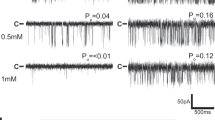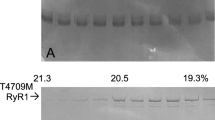Abstract
Many physiological events require transient increases in cytosolic Ca2+ concentrations. Ryanodine receptors (RyRs) are ion channels that govern the release of Ca2+ from the endoplasmic and sarcoplasmic reticulum1. Mutations in RyRs can lead to severe genetic conditions that affect both cardiac and skeletal muscle, but locating the mutated residues in the full-length channel structure has been difficult2,3. Here we show the 2.5 Å resolution crystal structure of a region spanning three domains of RyR type 1 (RyR1), encompassing amino acid residues 1–559. The domains interact with each other through a predominantly hydrophilic interface. Docking in RyR1 electron microscopy maps4,5 unambiguously places the domains in the cytoplasmic portion of the channel, forming a 240-kDa cytoplasmic vestibule around the four-fold symmetry axis. We pinpoint the exact locations of more than 50 disease-associated mutations in full-length RyR1 and RyR2. The mutations can be classified into three groups: those that destabilize the interfaces between the three amino-terminal domains, disturb the folding of individual domains or affect one of six interfaces with other parts of the receptor. We propose a model whereby the opening of a RyR coincides with allosterically coupled motions within the N-terminal domains. This process can be affected by mutations that target various interfaces within and across subunits. The crystal structure provides a framework to understand the many disease-associated mutations in RyRs that have been studied using functional methods, and will be useful for developing new strategies to modulate RyR function in disease states.
This is a preview of subscription content, access via your institution
Access options
Subscribe to this journal
Receive 51 print issues and online access
$199.00 per year
only $3.90 per issue
Buy this article
- Purchase on Springer Link
- Instant access to full article PDF
Prices may be subject to local taxes which are calculated during checkout




Similar content being viewed by others
References
Giannini, G., Conti, A., Mammarella, S., Scrobogna, M. & Sorrentino, V. The ryanodine receptor/calcium channel genes are widely and differentially expressed in murine brain and peripheral tissues. J. Cell Biol. 128, 893–904 (1995)
Betzenhauser, M. J. & Marks, A. R. Ryanodine receptor channelopathies. Pflügers Arch. 460, 467–480 (2010)
Robinson, R., Carpenter, D., Shaw, M. A., Halsall, J. & Hopkins, P. Mutations in RYR1 in malignant hyperthermia and central core disease. Hum. Mutat. 27, 977–989 (2006)
Ludtke, S. J., Serysheva, I. I., Hamilton, S. L. & Chiu, W. The pore structure of the closed RyR1 channel. Structure 13, 1203–1211 (2005)
Samsó, M., Wagenknecht, T. & Allen, P. D. Internal structure and visualization of transmembrane domains of the RyR1 calcium release channel by cryo-EM. Nature Struct. Mol. Biol. 12, 539–544 (2005)
MacLennan, D. H. & Chen, S. R. Store overload-induced Ca2+ release as a triggering mechanism for CPVT and MH episodes caused by mutations in RYR and CASQ genes. J. Physiol. (Lond.) 587, 3113–3115 (2009)
Amador, F. J. et al. Crystal structure of type I ryanodine receptor amino-terminal β-trefoil domain reveals a disease-associated mutation ‘hot spot’ loop. Proc. Natl Acad. Sci. USA 106, 11040–11044 (2009)
Lobo, P. A. & Van Petegem, F. Crystal structures of the N-terminal domains of cardiac and skeletal muscle ryanodine receptors: insights into disease mutations. Structure 17, 1505–1514 (2009)
Samsó, M., Feng, W., Pessah, I. N. & Allen, P. D. Coordinated movement of cytoplasmic and transmembrane domains of RyR1 upon gating. PLoS Biol. 7, e85 (2009)
Garzon, J. I., Kovacs, J., Abagyan, R. & Chacon, P. ADP_EM: fast exhaustive multi-resolution docking for high-throughput coverage. Bioinformatics 23, 427–433 (2007)
Chacón, P. & Wriggers, W. Multi-resolution contour-based fitting of macromolecular structures. J. Mol. Biol. 317, 375–384 (2002)
Serysheva, I. I., Hamilton, S. L., Chiu, W. & Ludtke, S. J. Structure of Ca2+ release channel at 14 Å resolution. J. Mol. Biol. 345, 427–431 (2005)
Liu, Z. et al. Three-dimensional reconstruction of the recombinant type 3 ryanodine receptor and localization of its amino terminus. Proc. Natl Acad. Sci. USA 98, 6104–6109 (2001)
Wang, R. et al. Localization of an NH2-terminal disease-causing mutation hot spot to the ‘clamp’ region in the three-dimensional structure of the cardiac ryanodine receptor. J. Biol. Chem. 282, 17785–17793 (2007)
Baker, M. L. et al. The skeletal muscle Ca2+ release channel has an oxidoreductase-like domain. Proc. Natl Acad. Sci. USA 99, 12155–12160 (2002)
Wriggers, W. & Chacón, P. Modeling tricks and fitting techniques for multiresolution structures. Structure 9, 779–788 (2001)
Serysheva, I. I. et al. Subnanometer-resolution electron cryomicroscopy-based domain models for the cytoplasmic region of skeletal muscle RyR channel. Proc. Natl Acad. Sci. USA 105, 9610–9615 (2008)
Bhuiyan, Z. A. et al. Expanding spectrum of human RYR2-related disease: new electrocardiographic, structural, and genetic features. Circulation 116, 1569–1576 (2007)
Marjamaa, A. et al. Search for cardiac calcium cycling gene mutations in familial ventricular arrhythmias resembling catecholaminergic polymorphic ventricular tachycardia. BMC Med. Genet. 10, 12 (2009)
Bellinger, A. M. et al. Hypernitrosylated ryanodine receptor calcium release channels are leaky in dystrophic muscle. Nature Med. 15, 325–330 (2009)
Durham, W. J. et al. RyR1 S-nitrosylation underlies environmental heat stroke and sudden death in Y522S RyR1 knockin mice. Cell 133, 53–65 (2008)
Eu, J. P., Sun, J., Xu, L., Stamler, J. S. & Meissner, G. The skeletal muscle calcium release channel: coupled O2 sensor and NO signaling functions. Cell 102, 499–509 (2000)
Xu, L., Eu, J. P., Meissner, G. & Stamler, J. S. Activation of the cardiac calcium release channel (ryanodine receptor) by poly-S-nitrosylation. Science 279, 234–237 (1998)
Aracena-Parks, P. et al. Identification of cysteines involved in S-nitrosylation, S-glutathionylation, and oxidation to disulfides in ryanodine receptor type 1. J. Biol. Chem. 281, 40354–40368 (2006)
Ikemoto, N. & Yamamoto, T. Regulation of calcium release by interdomain interaction within ryanodine receptors. Front. Biosci. 7, d671–d683 (2002)
Bosanac, I. et al. Structure of the inositol 1,4,5-trisphosphate receptor binding core in complex with its ligand. Nature 420, 696–700 (2002)
Bosanac, I. et al. Crystal structure of the ligand binding suppressor domain of type 1 inositol 1,4,5-trisphosphate receptor. Mol. Cell 17, 193–203 (2005)
Chan, J. et al. Ligand-induced conformational changes via flexible linkers in the amino-terminal region of the inositol 1,4,5-trisphosphate receptor. J. Mol. Biol. 373, 1269–1280 (2007)
Kabsch, W. XDS . Acta Crystallogr. D 66, 125–132 (2010)
McCoy, A. J. et al. Phaser crystallographic software. J. Appl. Cryst. 40, 658–674 (2007)
Van Petegem, F., Clark, K. A., Chatelain, F. C. & Minor, D. L., Jr Structure of a complex between a voltage-gated calcium channel β-subunit and an α-subunit domain. Nature 429, 671–675 (2004)
Langer, G., Cohen, S. X., Lamzin, V. S. & Perrakis, A. Automated macromolecular model building for X-ray crystallography using ARP/wARP version 7. Nature Protocols 3, 1171–1179 (2008)
Emsley, P. & Cowtan, K. Coot: model-building tools for molecular graphics. Acta Crystallogr. D 60, 2126–2132 (2004)
Murshudov, G. N., Vagin, A. A. & Dodson, E. J. Refinement of macromolecular structures by the maximum-likelihood method. Acta Crystallogr. D 53, 240–255 (1997)
Laskowski, R. A., Macarthur, M. W., Moss, D. S. & Thornton, J. M. PROCHECK: a program to check the stereochemical quality of protein structures. J. Appl. Cryst. 26, 283–291 (1993)
Volkmann, N. Confidence intervals for fitting of atomic models into low-resolution densities. Acta Crystallogr. D 65, 679–689 (2009)
Volkmann, N. & Hanein, D. Docking of atomic models into reconstructions from electron microscopy. Methods Enzymol. 374, 204–225 (2003)
Acknowledgements
We thank the staff at beamline 08ID-1 of the Canadian Light source, the Stanford Synchrotron Radiation Lightsource, K. Beam for the rabbit RyR1 clone, K. Lau for assistance with preparing the figures and the movie file, and C. Ahern, E. Moore and R. Pancaroglu for comments on the manuscript. F.V.P. is funded by the Canadian Institutes of Health Research (CIHR) and the Heart and Stroke Foundation of Canada, and is a CIHR new investigator and a Michael Smith Foundation for Health Research Scholar.
Author information
Authors and Affiliations
Contributions
C.-C.T. expressed, purified and crystallized the protein, and collected diffraction data. P.A.L. cloned several initial constructs and assisted with the melting curve analysis. L.K. prepared the disease-associated mutation, purified the corresponding protein and measured the melting curves. F.V.P. designed and supervised the experiments, collected diffraction data, solved the structure, performed the docking experiments, and wrote the manuscript.
Corresponding author
Ethics declarations
Competing interests
The authors declare no competing financial interests.
Supplementary information
Supplementary Information
The file contains a Supplementary Discussion, Supplementary Tables 1-3 and Supplementary Figures 1-7 with legends. (PDF 3564 kb)
Supplementary Movie 1
This movie file shows a rotation of the docked RyR1ABC crystal structure inside the 9.6Å cryoEM map of RyR1 in the closed state. (MOV 9601 kb)
Rights and permissions
About this article
Cite this article
Tung, CC., Lobo, P., Kimlicka, L. et al. The amino-terminal disease hotspot of ryanodine receptors forms a cytoplasmic vestibule. Nature 468, 585–588 (2010). https://doi.org/10.1038/nature09471
Received:
Accepted:
Published:
Issue Date:
DOI: https://doi.org/10.1038/nature09471
This article is cited by
-
Cysteines 1078 and 2991 cross-linking plays a critical role in redox regulation of cardiac ryanodine receptor (RyR)
Nature Communications (2023)
-
RyR1-related myopathy mutations in ATP and calcium binding sites impair channel regulation
Acta Neuropathologica Communications (2021)
-
Regulatory mechanisms of ryanodine receptor/Ca2+ release channel revealed by recent advancements in structural studies
Journal of Muscle Research and Cell Motility (2021)
-
Intracellular calcium leak in heart failure and atrial fibrillation: a unifying mechanism and therapeutic target
Nature Reviews Cardiology (2020)
-
Retrieving functional pathways of biomolecules from single-particle snapshots
Nature Communications (2020)
Comments
By submitting a comment you agree to abide by our Terms and Community Guidelines. If you find something abusive or that does not comply with our terms or guidelines please flag it as inappropriate.



